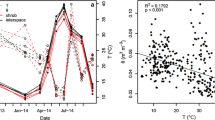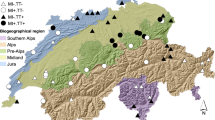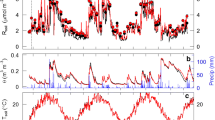Abstract
Soil respiration, the major pathway for ecosystem carbon (C) loss, has the potential to enter a positive feedback loop with the atmospheric CO2 due to climate warming. For reliable projections of climate-carbon feedbacks, accurate quantification of soil respiration and identification of mechanisms that control its variability are essential. Process-based models simulate soil respiration as functions of belowground C input, organic matter quality, and sensitivity to environmental conditions. However, evaluation and calibration of process-based models against the long-term in situ measurements are rare. Here, we evaluate the performance of the Terrestrial ECOsystem (TECO) model in simulating total and heterotrophic soil respiration measured during a 16-year warming experiment in a mixed-grass prairie; calibrate model parameters against these and other measurements collected during the experiment; and explore whether the mechanisms of C dynamics have changed over the years. Calibrating model parameters against observations of individual years substantially improved model performance in comparison to pre-calibration simulations, explaining 79–86% of variability in observed soil respiration. Interannual variation of the calibrated model parameters indicated increasing recalcitrance of soil C and changing environmental sensitivity of microbes. Overall, we found that (1) soil organic C became more recalcitrant in intact soil compared to root-free soil; (2) warming offset the effects of increasing C recalcitrance in intact soil and changed microbial sensitivity to moisture conditions. These findings indicate that soil respiration may decrease in the future due to C quality, but this decrease may be offset by warming-induced changes in C cycling mechanisms and their responses to moisture conditions.






Similar content being viewed by others
References
Adams HD, Williams AP, Xu C, Rauscher SA, Jiang X, McDowell NG (2013) Empirical and process-based approaches to climate-induced forest mortality models. Front Plant Sci 4:438. https://doi.org/10.3389/fpls.2013.00438
Agren GI, Bosatta N (1987) Theoretical analysis of the long-term dynamics of carbon and nitrogen in soils. Ecology 68:1181–1189. https://doi.org/10.2307/1939202
Allison SD (2014) Modeling adaptation of carbon use efficiency in microbial communities. Front Microbiol 5:571. https://doi.org/10.3389/fmicb.2014.00571
Allison SD, Treseder KK (2008) Warming and drying suppress microbial activity and carbon cycling in boreal forest soils. Glob Change Biol 14:2898–2909. https://doi.org/10.1111/j.1365-2486.2008.01716.x
Allison SD, Wallenstein MD, Bradford MA (2010) Soil-carbon response to warming dependent on microbial physiology. Nat Geosci 3:336–340. https://doi.org/10.1038/ngeo846
Alster CJ, Baas P, Wallenstein MD, Johnson NG, von Fischer JC (2016a) Temperature sensitivity as a microbial trait using parameters from macromolecular rate theory. Front Microbiol 7:1821. https://doi.org/10.3389/fmicb.2016.01821
Alster CJ, Koyama A, Johnson NG, Wallenstein MD, von Fischer JC (2016b) Temperature sensitivity of soil microbial communities: an application of macromolecular rate theory to microbial respiration. J Geophys Res Biogeosci 121:1420–1433. https://doi.org/10.1002/2016JG003343
Baer S, Kitchen D, Blair J, Rice C (2002) Changes in ecosystem structure and function along a chronosequence of restored grasslands. Ecol Appl 12:1688–1701. https://doi.org/10.1890/1051-0761(2002)012[1688:CIESAF]2.0.CO;2
Beguería S, Vicente-Serrano SM, Reig F, Latorre B (2014) Standardized precipitation evapotranspiration index (SPEI) revisited: parameter fitting, evapotranspiration models, tools, datasets and drought monitoring. Int J Climatol 34:3001–3023. https://doi.org/10.1002/joc.3887
Beguería S, Vicente-Serrano SM, Beguería MS (2017) Package ‘SPEI’.
Birch H (1958) The effect of soil drying on humus decomposition and nitrogen availability. Plant Soil 10:9–31. https://doi.org/10.1007/BF01343734
Bond-Lamberty B, Thomson A (2010) A global database of soil respiration data. Biogeosciences 7:1915–1926. https://doi.org/10.5194/bg-7-1915-2010
Brock FV et al (1995) The Oklahoma Mesonet: a technical overview. J Atmos Ocean Technol 12:5–19. https://doi.org/10.1175/1520-0426(1995)012%3c0005:TOMATO%3e2.0.CO;2
Carey JC et al (2016) Temperature response of soil respiration largely unaltered with experimental warming. Proc Natl Acad Sci USA 113:13797–13802. https://doi.org/10.1073/pnas.1605365113
Cheng W et al (2014) Synthesis and modeling perspectives of rhizosphere priming. New Phytol 201:31–44. https://doi.org/10.1111/nph.12440
Clark JS et al (2001) Ecological forecasts: an emerging imperative. Science 293:657–660. https://doi.org/10.1126/science.293.5530.657
Cotrufo MF, Wallenstein MD, Boot CM, Denef K, Paul E (2013) The Microbial Efficiency-Matrix Stabilization (MEMS) framework integrates plant litter decomposition with soil organic matter stabilization: do labile plant inputs form stable soil organic matter? Glob Change Biol 19:988–995. https://doi.org/10.1111/gcb.12113
Cox PM, Betts RA, Jones CD, Spall SA, Totterdell IJ (2000) Acceleration of global warming due to carbon-cycle feedbacks in a coupled climate model. Nature 408:184–187. https://doi.org/10.1038/35041539
Feng W et al (2017) Enhanced decomposition of stable soil organic carbon and microbial catabolic potentials by long-term field warming. Glob Chang Biol 23:4765–4776. https://doi.org/10.1111/gcb.13755
Fierer N, Craine JM, McLauchlan K, Schimel JP (2005) Litter quality and the temperature sensitivity of decomposition. Ecology 86:320–326. https://doi.org/10.1890/04-1254
Fontaine S, Barot S, Barre P, Bdioui N, Mary B, Rumpel C (2007) Stability of organic carbon in deep soil layers controlled by fresh carbon supply. Nature 450:277–280. https://doi.org/10.1038/nature06275
Fox AM et al (2018) Evaluation of a data assimilation system for land surface models using CLM4. 5. J Adv Model Earth Syst 10:2471–2494. https://doi.org/10.1029/2018MS001362
Frank DA, McNaughton SJ (1990) Aboveground biomass estimation with the canopy intercept method: a plant growth form caveat. Oikos. https://doi.org/10.2307/3565736
Friedlingstein P et al (2006) Climate–carbon cycle feedback analysis: results from the C4MIP model intercomparison. J Clim 19:3337–3353. https://doi.org/10.1175/JCLI3800.1
Fuchslueger L et al (2016) Drought history affects grassland plant and microbial carbon turnover during and after a subsequent drought event. J Ecol 104:1453–1465. https://doi.org/10.1111/1365-2745.12593
Gao YZ, Giese M, Lin S, Sattelmacher B, Zhao Y, Brueck H (2008) Belowground net primary productivity and biomass allocation of a grassland in Inner Mongolia is affected by grazing intensity. Plant Soil 307:41–50. https://doi.org/10.1007/s11104-008-9579-3
Geyer KM, Kyker-Snowman E, Grandy AS, Frey SD (2016) Microbial carbon use efficiency: accounting for population, community, and ecosystem-scale controls over the fate of metabolized organic matter. Biogeochemistry 127:173–188. https://doi.org/10.1007/s10533-016-0191-y
Hanson PJ, Edwards NT, Garten CT, Andrews JA (2000) Separating root and soil microbial contributions to soil respiration: a review of methods and observations. Biogeochemistry 48:115–146. https://doi.org/10.1023/a:1006244819642
Hastings WK (1970) Monte Carlo sampling methods using Markov chains and their applications. Biometrika 57:97–109. https://doi.org/10.1093/biomet/57.1.97
Heimann M, Reichstein M (2008) Terrestrial ecosystem carbon dynamics and climate feedbacks. Nature 451:289–292. https://doi.org/10.1038/nature06591
Hobbs JK, Jiao W, Easter AD, Parker EJ, Schipper LA, Arcus VL (2013) Change in heat capacity for enzyme catalysis determines temperature dependence of enzyme catalyzed rates. ACS Chem Biol 8:2388–2393. https://doi.org/10.1021/cb4005029
Huang Y et al (2018a) Matrix approach to land carbon cycle modeling: a case study with the Community Land Model. Glob Chang Biol 24:1394–1404. https://doi.org/10.1111/gcb.13948
Huang Y et al (2018b) Matrix-based sensitivity assessment of soil organic carbon storage: a case study from the ORCHIDEE-MICT model. J Adv Model Earth Syst 10:1790–1808. https://doi.org/10.1029/2017MS001237
Jung CG et al (2019) Experimental warming amplified opposite impacts of drought vs. wet extremes on ecosystem carbon cycle in a tallgrass prairie. Agric For Meteorol 276:107635. https://doi.org/10.1016/j.agrformet.2019.107635
Keenan TF, Davidson EA, Munger JW, Richardson AD (2013) Rate my data: quantifying the value of ecological data for the development of models of the terrestrial carbon cycle. Ecol Appl 23:273–286. https://doi.org/10.1890/12-0747.1
Knorr W, Prentice IC, House JI, Holland EA (2005) Long-term sensitivity of soil carbon turnover to warming. Nature 433:298–301. https://doi.org/10.1038/nature03226
Lado-Monserrat L, Lull C, Bautista I, Lidón A, Herrera R (2014) Soil moisture increment as a controlling variable of the “Birch effect”. Interactions with the pre-wetting soil moisture and litter addition. Plant Soil 379:21–34. https://doi.org/10.1007/s11104-014-2037-5
Li J et al (2019) Reduced carbon use efficiency and increased microbial turnover with soil warming. Glob Change Biol 25:900–910. https://doi.org/10.1111/gcb.14517
Liang J et al (2018) Biotic responses buffer warming-induced soil organic carbon loss in Arctic tundra. Glob Change Biol 24:4946–4959. https://doi.org/10.1111/gcb.14325
Loladze I (2002) Rising atmospheric CO2 and human nutrition: toward globally imbalanced plant stoichiometry? Trends Ecol Evol 17:457–461. https://doi.org/10.1016/S0169-5347(02)02587-9
Lu M et al (2013) Responses of ecosystem carbon cycle to experimental warming: a meta-analysis. Ecology 94:726–738. https://doi.org/10.1890/12-0279.1
Luo Y, Schuur EA (2020) Model parameterization to represent processes at unresolved scales and changing properties of evolving systems. Glob Change Biol 26:1109–1117. https://doi.org/10.1111/gcb.14939
Luo Y et al (2011) Coordinated approaches to quantify long-term ecosystem dynamics in response to global change. Glob Change Biol 17:843–854. https://doi.org/10.1111/j.1365-2486.2010.02265.x
Luo Y, Keenan TF, Smith M (2015) Predictability of the terrestrial carbon cycle. Glob Chang Biol 21:1737–1751. https://doi.org/10.1111/gcb.12766
Manzoni S, Taylor P, Richter A, Porporato A, Agren GI (2012) Environmental and stoichiometric controls on microbial carbon-use efficiency in soils. New Phytol 196:79–91. https://doi.org/10.1111/j.1469-8137.2012.04225.x
McCarthy MA (2007) Bayesian methods for ecology. Cambridge University Press, Cambridge
McEvoy DJ, Huntington J, Abatzoglou J (2013) A comparison of the standardized precipitation evapotranspiration index using the penman-monteith and thornthwaite parameterizations for potential evapotranspiration. In: 93rd American meteorological society annual meeting
McPherson RA et al (2007) Statewide monitoring of the mesoscale environment: a technical update on the Oklahoma Mesonet. J Atmos Ocean Technol 24:301–321. https://doi.org/10.1175/JTECH1976.1
Melillo JM et al (2002) Soil warming and carbon-cycle feedbacks to the climate system. Science 298:2173–2176. https://doi.org/10.1126/science.1074153
Melillo JM et al (2017) Long-term pattern and magnitude of soil carbon feedback to the climate system in a warming world. Science 358:101–105. https://doi.org/10.1126/science.aan2874
Metropolis N, Rosenbluth AW, Rosenbluth MN, Teller AH, Teller E (1953) Equation of state calculations by fast computing machines. J Chem Phys 21:1087–1092. https://doi.org/10.1063/1.1699114
Niu S, Sherry RA, Zhou X, Luo Y (2013) Ecosystem carbon fluxes in response to warming and clipping in a tallgrass prairie. Ecosystems 16:948–961. https://doi.org/10.1007/s10021-013-9661-4
Or D, Smets BF, Wraith JM, Dechesne A, Friedman SP (2007) Physical constraints affecting bacterial habitats and activity in unsaturated porous media—a review. Adv Water Resour 30:1505–1527. https://doi.org/10.1016/j.advwatres.2006.05.025
Post J, Hattermann FF, Krysanova V, Suckow F (2008) Parameter and input data uncertainty estimation for the assessment of long-term soil organic carbon dynamics. Environ Model Softw 23:125–138. https://doi.org/10.1016/j.envsoft.2007.05.010
R-Core-Team (2019) R: A language and environment for statistical computing
Rodríguez-Iturbe I, Porporato A (2007) Ecohydrology of water-controlled ecosystems: soil moisture and plant dynamics. Cambridge University Press, Cambridge
Rustad L et al (2001) A meta-analysis of the response of soil respiration, net nitrogen mineralization, and aboveground plant growth to experimental ecosystem warming. Oecologia 126:543–562. https://doi.org/10.1007/s004420000544
Savage K, Davidson E (2001) Interannual variation of soil respiration in two New England forests. Global Biogeochem Cycles 15:337–350. https://doi.org/10.1029/1999GB001248
Schimel JP (2018) Life in dry soils: effects of drought on soil microbial communities and processes. Annu Rev Ecol Evol Syst 49:409–432. https://doi.org/10.1146/annurev-ecolsys-110617-062614
Schmidt MW et al (2011) Persistence of soil organic matter as an ecosystem property. Nature 478:49. https://doi.org/10.1038/nature10386
Sheik CS, Beasley WH, Elshahed MS, Zhou X, Luo Y, Krumholz LR (2011) Effect of warming and drought on grassland microbial communities. ISME J 5:1692–1700. https://doi.org/10.1038/ismej.2011.32
Sherry RA et al (2008) Lagged effects of experimental warming and doubled precipitation on annual and seasonal aboveground biomass production in a tallgrass prairie. Glob Change Biol 14:2923–2936. https://doi.org/10.1111/j.1365-2486.2008.01703.x
Shi Z et al (2015a) Evidence for long-term shift in plant community composition under decadal experimental warming. J Ecol 103:1131–1140. https://doi.org/10.1111/1365-2745.12449C
Shi Z et al (2015b) Experimental warming altered rates of carbon processes, allocation, and carbon storage in a tallgrass prairie. Ecosphere 6:1–16. https://doi.org/10.1890/ES14-00335.1
Shi Z et al (2018) Successional change in species composition alters climate sensitivity of grassland productivity. Glob Chang Biol 24:4993–5003. https://doi.org/10.1111/gcb.14333
Silver WL, Miya RK (2001) Global patterns in root decomposition: comparisons of climate and litter quality effects. Oecologia 129:407–419. https://doi.org/10.1007/s004420100740
Stocker TF (2014) Climate change 2013: the physical science basis: Working Group I contribution to the Fifth assessment report of the Intergovernmental Panel on Climate Change. Cambridge University Press, Cambridge
Subke J-A, Inglima I, Francesca Cotrufo M (2006) Trends and methodological impacts in soil CO2 efflux partitioning: a metaanalytical review. Glob Change Biol 12:921–943. https://doi.org/10.1111/j.1365-2486.2006.01117.x
Sun OJ, Campbell J, Law BE, Wolf V (2004) Dynamics of carbon stocks in soils and detritus across chronosequences of different forest types in the Pacific Northwest, USA. Glob Change Biol 10:1470–1481. https://doi.org/10.1111/j.1365-2486.2004.00829.x
Suseela V, Conant RT, Wallenstein MD, Dukes JS (2012) Effects of soil moisture on the temperature sensitivity of heterotrophic respiration vary seasonally in an old-field climate change experiment. Glob Change Biol 18:336–348. https://doi.org/10.1111/j.1365-2486.2011.02516.x
Torn M, Swanston C, Castanha C, Trumbore S (2009) Storage and turnover of organic matter in soil. In: Biophysico-chemical processes involving natural nonliving organic matter in environmental systems. Wiley, Hoboken, pp 219–272. https://doi.org/10.1002/9780470494950.ch6
Trumbore S (2006) Carbon respired by terrestrial ecosystems–recent progress and challenges. Glob Change Biol 12:141–153. https://doi.org/10.1111/j.1365-2486.2006.01067.x
Van der Schrier G, Jones P, Briffa K (2011) The sensitivity of the PDSI to the Thornthwaite and Penman-Monteith parameterizations for potential evapotranspiration. J Geophys Res Atmos. https://doi.org/10.1029/2010JD015001
Vicente-Serrano SM, Beguería S, López-Moreno JI (2010) A multiscalar drought index sensitive to global warming: the standardized precipitation evapotranspiration index. J Clim 23:1696–1718. https://doi.org/10.1175/2009JCLI2909.1
Wan S, Luo Y, Wallace LL (2002) Changes in microclimate induced by experimental warming and clipping in tallgrass prairie. Glob Change Biol 8:754–768. https://doi.org/10.1046/j.1365-2486.2002.00510.x
Wan S, Norby RJ, Ledford J, Weltzin JF (2007) Responses of soil respiration to elevated CO2, air warming, and changing soil water availability in a model old-field grassland. Glob Change Biol 13:2411–2424. https://doi.org/10.1111/j.1365-2486.2007.01433.x
Wang Y-P, Leuning R (1998) A two-leaf model for canopy conductance, photosynthesis and partitioning of available energy I: Model description and comparison with a multi-layered model. Agric For Meteorol 91:89–111. https://doi.org/10.1016/S0168-1923(98)00061-6
Wang Y-P, Trudinger CM, Enting IG (2009) A review of applications of model–data fusion to studies of terrestrial carbon fluxes at different scales. Agric For Meteorol 149:1829–1842. https://doi.org/10.1016/j.agrformet.2009.07.009
Wedin DA, Tilman D (1990) Species effects on nitrogen cycling: a test with perennial grasses. Oecologia 84:433–441. https://doi.org/10.1007/BF00328157
Weng E, Luo Y (2008) Soil hydrological properties regulate grassland ecosystem responses to multifactor global change: a modeling analysis. J Geophys Res Biogeosci. https://doi.org/10.1029/2007JG000539
Wu Z, Dijkstra P, Koch GW, Peñuelas J, Hungate BA (2011) Responses of terrestrial ecosystems to temperature and precipitation change: a meta-analysis of experimental manipulation. Glob Change Biol 17:927–942. https://doi.org/10.1111/j.1365-2486.2010.02302.x
Xu T, White L, Hui D, Luo Y (2006) Probabilistic inversion of a terrestrial ecosystem model: analysis of uncertainty in parameter estimation and model prediction. Glob Biogeochem Cycles. https://doi.org/10.1029/2005GB002468
Xu X, Zhou Y, Ruan H, Luo Y, Wang J (2010) Temperature sensitivity increases with soil organic carbon recalcitrance along an elevational gradient in the Wuyi Mountains, China. Soil Biol Biochem 42:1811–1815. https://doi.org/10.1016/j.soilbio.2010.06.021
Zhou X, Wan S, Luo Y (2007) Source components and interannual variability of soil CO2 efflux under experimental warming and clipping in a grassland ecosystem. Glob Change Biol 13:761–775. https://doi.org/10.1111/j.1365-2486.2007.01333.x
Zhou X, Weng E, Luo Y (2008) Modeling patterns of nonlinearity in ecosystem responses to temperature, CO2, and precipitation changes. Ecol Appl 18:453–466. https://doi.org/10.1890/07-0626.1
Zhou X et al (2010) Concurrent and lagged impacts of an anomalously warm year on autotrophic and heterotrophic components of soil respiration: a deconvolution analysis. New Phytol 187:184–198. https://doi.org/10.1111/j.1469-8137.2010.03256.x
Zhou X, Xu X, Zhou G, Luo Y (2018) Temperature sensitivity of soil organic carbon decomposition increased with mean carbon residence time: field incubation and data assimilation. Glob Change Biol 24:810–822. https://doi.org/10.1111/gcb.13994
Acknowledgements
This manuscript is to be published as part of a Special Issue honoring Dr. Russell Monson. We appreciate particularly Dr. Monson’s contributions to ecophysiology. The authors thank many members of Dr. Yiqi Luo’s lab for their help with field measurements. This work was financially supported by National Science Foundation Grant DEB 1655499, US Department of Energy (DOE), Terrestrial Ecosystem Sciences Grant DE-SC0020227 and the subcontracts 4000158404 from Oak Ridge National Laboratory (ORNL) to Northern Arizona University. ORNL’s work was supported by the DOE, Office of Science, Office of Biological and Environmental Research. ORNL is managed by UT-Battelle, LLC, for DOE under contract DE-AC05-00OR22725.
Author information
Authors and Affiliations
Contributions
YL conceived and designed the experiments. CGJ, ZD, XX, JL, XZ, DL, and LJ collected the data. CGJ and ZD contributed model structure and coding. CGJ, OH, and LJ performed data analysis. CGJ wrote the first draft. All authors contributed extensively to the ideas, writing and discussions.
Corresponding authors
Ethics declarations
Conflict of interest
The authors declare no conflict of interest.
Additional information
Communicated by Paul Stoy.
Supplementary Information
Below is the link to the electronic supplementary material.
Rights and permissions
About this article
Cite this article
Jung, C.G., Du, Z., Hararuk, O. et al. Long-term measurements in a mixed-grass prairie reveal a change in soil organic carbon recalcitrance and its environmental sensitivity under warming. Oecologia 197, 989–1002 (2021). https://doi.org/10.1007/s00442-021-04875-1
Received:
Accepted:
Published:
Issue Date:
DOI: https://doi.org/10.1007/s00442-021-04875-1




